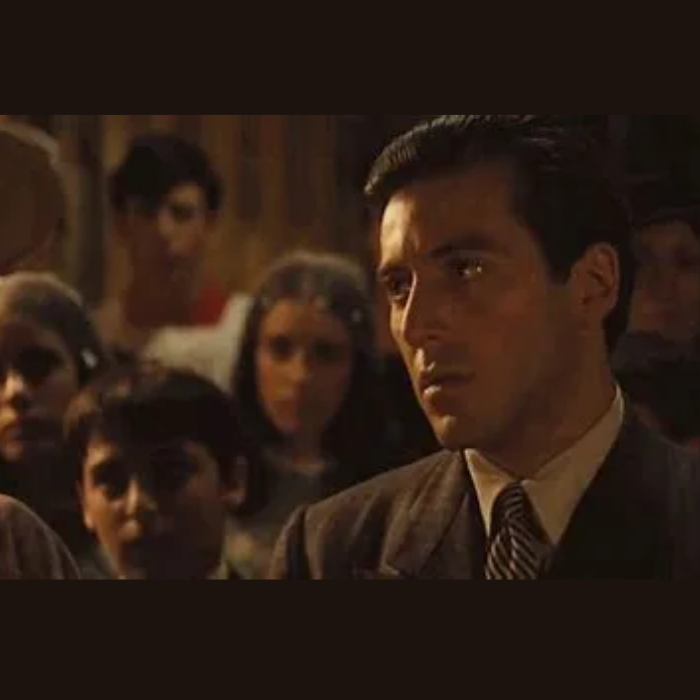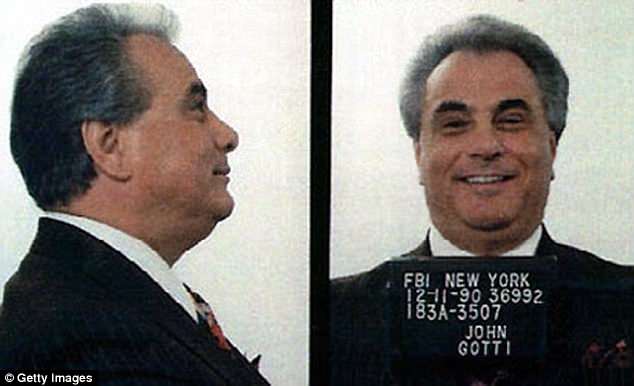“That I may courageously resist the seductions of the world, evil companions, bad books, and films.”
-Words taken from the Novena to Our Lady of Perpetual Help
Some day, and the day WILL come, Our Lord will call upon you to give an account of your entire life. Until that day, accept God’s gratuitous mercy as a gift.
In the meantime, how well have you prepared yourself for judgment by avoiding evil companions, bad books, and films?
Well, if you enjoy the Godfather trilogy (even just the first two films), then you may be hindering your preparation by consuming a plethora of offensive debauchery. This alleged cinematic masterpiece, a favorite even among Catholics, contradicts numerous faith/moral elements, and exposes the viewer to several scandalous horrors (impermissible for motion-picture simulations).
I’ll explain the details in a moment, but here’s a snapshot of the various gratuitous features found in each film (courtesy of IMDB).
- Godfather 1 (1972):
- Lord’s Name in Vain – 7 times
- Sex & Nudity – 6X
- F-Bombs – 2X (in Italian as “V-bombs”)
- Violence & Gore – 11X
- Frightening/Intense Scenes – 6X
- Godfather 2 (1974):
- Lord’s Name in Vain – 16X
- Sex & Nudity – 5X
- F-Bombs – 3X
- Violence & Gore – 14X
- Frightening/Intense Scenes – 6X
- Godfather 3 (1990):
- Lord’s Name in Vain – 0
- Sex & Nudity – 3X
- F-Bombs – 15X
- Violence & Gore – 10X
- Frightening/Intense Scenes – 4X
Of course, considering mere raw numbers won’t provide a complete story. So, I’ll try to summarize the trouble with The Godfather without devoting excessive attention to its abundant filth.
NOTE: This is not a good article for children.
Godfather Trilogy: Degeneracy From the Beginning

The beginning of Godfather has a semi-stealth way of introducing evil; melding it into an ostensibly charming wedding scene with lots of cheery Italian music.
Most of this scene reflects the filmmaker’s intent to showcase the thin veneer of mafia culture, wrought with corruption and depravity. Although there’s nothing intrinsically wrong with that ambition, The Godfather does so by intertwining a medley of good and evil. It confuses the viewer by leaving him wondering if what he saw was “somewhat flawed, but still good” or just plain evil.
In one take, the audience watches children and adults dancing to jolly folk music. Then the camera switches to a mafioso getting drunk and stealing from the bridal purse. Despite the peaceful wedding ambiance, the FBI/media sneak in to fight with mobsters to snap photos of one of the rival bosses.
This is nothing compared to the semi-hidden sexual innuendo the filmmaker fits into the scene. There, the audience is treated to an image of a woman bragging about her husband’s penis size (with hand gestures) among female friends at the wedding. This may be less than obvious to the more innocent viewer, but it’s also not a well-hidden secret, either.
It gets worse, though.
The joke is on this poor, proud wife, since she is about to become a third-degree cuckquean (while the wedding party continues). That’s because her husband, Sonny Corleone, would run into the family mansion to commit adultery with a girl in a pink dress, which the filmmaker insists be simulated on screen. There’s no direct nudity, but plenty of noises, facial expressions, and implied/simulated penetration (none of which is mere innuendo).
Don’t worry because there would be indirect retribution for that adultery with plenty of outrageous blood and gore later. The groom from the wedding (Carlo, a disgruntled, passed-over mafia-middling) would conspire with the other mobsters to kill Sonny for after receiving a beating from him. Yes, and the film shows this poor sap shot dead with dozens of rounds fired at him by several mafia killers at a toll booth.
This is what passes for authentic Italian entertainment in the early 1970s (based on an earlier novelization).
As a whole, the explosive, perverted family drama (across all three films, becoming progressively worse) is little more than Sicilian-style Jerry Springer. The only thing missing is an exuberant Italian audience chanting: Gerardo! Gerardo! Gerardo!
Ah, but we’re just getting started.
Do you enjoy the sight of beautiful Italian women topless in movies? Well, if you’re Catholic, you should not, because it’s gravely sinful (it even got King David into serious trouble).
The Godfather would like you to dismiss such “scrupulosity,” however, and enjoy the site of the Italian actress, displayed without clothing. She and Michael Corleone, just got married and were prepared to consummate it. The filmmakers didn’t want to deprive you of the opportunity to witness how it began. What reasonable Catholic could object to such a necessary story-telling instrument?
We can wonder if this would have made it into the film if the National Legion of Decency hadn’t lost all of its teeth in the previous decade before Godfather.
The Death of Luca Brasi
Here’s a scene where it takes three men to kill the large bruiser/enforcer, Luca Brasi.
While there’s always some need to suspend disbelief in order to enjoy a movie, this part demands a lot. It involves one character pinning Brasi’s hand to the bar, another one stabbing the other hand, while a third guy strangles him with garrote wire. The viewer then gets to watch the big fellow die slowly from asphyxiation with plenty of requisite gurgling noises (quite the novelty in 1972).
Why in blazes did these mafia knot-heads concoct such a bizarre way to kill this dude? Couldn’t the guy with the garrote wire have just slipped in and shot him?
Why didn’t they listen to that other part of the film, where Sonny encourages his brother to shoot when he’s “right up on the guy” (*Bada-bing*)? Ultimately, since the producer, Francis Ford Coppola, was a proto-Quentin Tarantino, and therefore obsessed with violence and “shock factor,” he had to make everything as gruesome as possible.
I’m not even going to bother with the absurd “horse’s head” scene.
Subliminal (or Overt) Mockery of Catholic Sacraments

“Ah, but Godfather does a terrific job of subtly exposing an American audience to certain aspects of Catholicism.”
Well, then let’s investigate how the films accomplish this. For starters, what’s the best thing for godparents to do during a Baptism?
I know that could be too rhetorical and complex for modern Catholics, but, according to Godfather I, you should use it as an opportunity to murder your political enemies. That’s what the notorious protagonist, Michael Corleone, accomplished by using the baptism of his nephew as a cover/alibi, while his mafia goons whacked all of New York’s other bosses.
“Do you renounce Satan, and all his works, and all his pomps?” “Yeah, sure, why not?”
Why would this matter?
I can almost guarantee if you ask your typical American about Catholic baptisms, especially the “old-fashioned way,” this movie scene is what they’d mention. Is that a positive and inspiring example? No, but the filmmaker inserts this and similar sacrileges all throughout this ill-begotten trilogy.
Let’s hope they didn’t introduce any sly ways to insult the Blessed Virgin.
Ah, but alas, in Godfather II, the increasingly psychopathic Michael Corleone orders the murder of his own brother (admittedly a traitor, who earns his fate). While the loss of an unlikable character, like Fredo, shouldn’t break anyone’s heart, I invite the Catholic reader to examine a fascinating and grim aspect of the murder scene.

What was Fredo doing right as he got shot on the fishing boat?
Like any Catholic fisherman would do, he was praying the Hail Mary . . . right before being suddenly shot in the head, culminating the hour of his death. I suppose you could analyze this several ways, but it’s amazing to see the filmmaker depict Fredo’s execution simultaneously with a beloved Catholic prayer. This is all the more compelling because it’s the one we always use to beseech Our Lady for that most necessary aid, and to avoid a sudden and untimely death.
Does the filmmaker wish to imply . . . that it doesn’t work?
Remember, this is along with the baptism scene, the loathsome wedding feast, and several other dubious portrayals of Catholicism. Later, I’ll discuss the film series’ depiction of clergy and confession.
Other Miscellaneous Blood & Gore
Perhaps I haven’t covered the violent details sufficiently, so let’s review some others from these iconic films.
Would you like to see a man slit his wrist and “die honorably” in a bathtub?
Well, you won’t get to see it in motion, but Godfather II allows you to witness the gruesome remains of mafioso, Frank Pentangeli, after his honorable suicide. The storyline explains how this is what all pagans men-of-honor do when they’ve gotten caught in betrayal. Someone should have gotten the message out to silly Fredo, who spent his time fishing and praying Hail Mary’s.
If this wicked behavior sounds familiar, it’s a tiresome motif that you would find among other desperate Italian pagans throughout history.
What About the Critical Flop, Godfather III?
I’ve never seen this movie all the way through (only clips and pieces) but if you enjoy watching implicit incest, poor acting, and lazy writing . . .
“Gerardo! Gerardo! Gerardo!”
I recall, however, that the film has an interesting ending. This is where you’ll see the elderly Michael Corleone still lamenting the loss of his wife from the car explosion. He then suffers a sudden death, without the sacraments of the Church. Since earlier in the film, he made an invalid confession (without repentance, wrong form, no absolution, etc.), we’re led to believe that Michael’s chances of salvation are rather bleak.
“But isn’t it sooooooo nice that this film series has a lot of references to the sacraments?”
Yes, if it didn’t blaspheme almost all of them.
Major Issues with the Sicilian Mafia
Now that I’ve demonstrated the appalling nature of these fictional mafia accounts, let’s see how the “real deal” fairs by comparison. Like all other organized crime outfits, these are secret societies, which receive the same papal disapprobation as Freemasonry. Pope Leo XIII, for example, mentions that term twice in his anti-freemason encyclical, Humanum Genus, with plenty of criticisms that apply to all secretive groups (including mafias, rackets, and gangs).
Behold a modest sampling of American/Sicilian mafia evil.
- What’s it like becoming a “made man”? The initiation ceremonies are complete works of blasphemy, which pervert many aspects of Catholic liturgy. Many Italian mafias, for example, require a blood oath where the new “soldado” burns a picture of a saint. It’s like an inverse Confirmation.
- In some contexts, the blood component gets even worse. Some ceremonies are a direct mockery of Our Lord’s crucifixion when they involve a ritual of slicing the candidate’s lip, allowing the blood to soak a skull. This is an obvious perversion of Our Lord’s sacrifice where he shed his blood at Golgotha (the resting place of Adam’s skull; awaiting redemption).
- The Mafia, like the Church, has a hierarchy, complete with plenty of subsidiarity and structure (bosses, underbosses, captains, soldiers, associates, and so forth). Unlike the Church, it uses this structure to instill fear, manipulate businesses and politicians, and perpetrate innumerable crimes. The Church exists for salvation; mafias for exploitation.
- Almost all mafia interactions with “civilians” includes extortion and usury (loan-sharking). So, in contrast with the true Church, which only solicits voluntary donations, the mafia demands you “pay up, or die!”

Decent Practical Lessons & Red Pills from the Godfather
Are there any positive elements or useful takeaways from this otherwise unacceptable movie trilogy? Yes, honesty compels me to admit that you can learn a great deal about human behavior (amid copious servings of violence and sexual obscenity).
Michael Corleone & Diabolical Narcissism
Some commentators, like Ann Barnhardt, might find the Godfather films useful for analysis because they’re a veritable “who’s who” of cinematic narcissists (including at least one diabolical narcissist).
According to Barnhardt, a diabolical narcissist is someone who willfully extinguishes every fiber of charity (love) from his heart. Examples of this include Lucifer, every fallen angel, almost every modern politician, and a disproportionate part of the Millennial Generation. They completely divorce themselves from willing any good for others in favor of exalting themselves. Often, but not always, the descent into diabolical narcissism happens after a traumatic event.
Barnhardt shows a fascinating fictional example of this in the 1951 adaptation of A Christmas Carol. There’s a particular scene where a young Ebeneezer Scrooge languishes from the death of his beloved sister. You can pinpoint the precise moment (her death) when Scrooge abandons any semblance of love, becomes a narcissist, and devotes the rest of his life to usury.
Has that ever happened to any other fictional young men?
After Michael Corleone witnesses the brutal murder of his wife in Italy, he sheds every morsel of love, almost in an instant (just like Scrooge). That event launched his career as a diabolical narcissistic crime boss, inaugurating his assumption to power by slaughtering four other mafia dons, Moe Green, and his brother-in-law. It’s a salutary lesson regarding what people can become when they choose to rid themselves of charity.
Do we ever see real-life examples of this?
Then there’s the quasi-narcissist, Vito Corleone (especially in Godfather II). I don’t know that you can call him a full-fledged “diabolical” narcissist because his violent streak seemed to reflect a genuine concern for his family. However, he exposed his willingness to kill, like a man with ice water in his veins, by eliminating the local tyrant, Don Fanucci. Although, in many ways heroic, this is not how psychologically healthy people behave. In reality, it takes quite a lot to get most of us to kill someone.
For what it’s worth, some of us might recognize similarities between Don Fanucci and Antipope Bergoglio: since both are obnoxious dictators, overconfident in their false invincibility.
Remember, however, that the Corleone dons were the “heroes” or “semi-good guys” of the film trilogy. If you include the films’ almost limitless villains (Sollozzo, Don Barzini, Hyman Roth, and even “Sunshine” Corleone), you could assemble an entire squadron of narcissists.
“Offers You Can’t Refuse”
Here’s another Barnhardt-ish topic: the invalidity and ridiculousness of contracts brought about by intimidation and coercion. During Godfather I’s horrendous wedding scene, we also get a whiff of the mob’s brutality, which might remind us of the coerced (and/or erroneous) resignation of Pope Benedict XVI.
Recall the part where Michael Corleone explains how Vito Corleone got his godson into the music business by intimidating a band leader.
Michael: My father made him an offer he couldn’t refuse.
Kay Adams: What was that?
Michael: Luca Brasi held a gun to his head, and my father assured him that either his brains or his signature would be on the contract.
Hopefully, a discerning eye can see why such a contract would be null and void. Extortion (a tactic designed to solicit grave fear) ALWAYS invalidates a contract (whether a business agreement, resignation, final Will and Testament, or any others).
This is also a critical ingredient in comprehending Pope Benedict’s bizarre resignation, almost certainly instigated by the St. Gallen Mafia, the CIA, and other treacherous actors. For further comprehension, see Canon 188, regarding grave fear. The “offer you can’t refuse” example clearly illustrates the invalidity of such arrangements.
It also reminds us of how often this despicable practice happens. We don’t even need Catholic canon law to recognize evil, fallacious contracts. Natural law and common sense are more than sufficient.
Decent Depiction of Real-Life Mafia Affairs

As I mentioned, the real-life mafia is 100% unacceptable for Catholics. However, I’d like to acknowledge The Godfather’s substantial evidence corroborating the typical, dismal fate of most mafiosos.
Most modern, real-life mobsters enjoy a miniscule life expectancy or job tenure. Like almost all criminals, they find themselves in jail/prison multiple times throughout their teenage and adult lives.
You can see this clearly by reviewing Wikipedia’s helpful timeline of the various NY mafia dons. If you scroll halfway down the page, you’ll discover the rapid turnover at the highest ranks. Among just the infamous “Five Families,” there have been over 90 bosses and acting bosses over about a century. Why would anyone risk taking such a horrible position if it lands you dead or in a cage within five years on average?
Let this be an outstanding reminder of why we must avoid worldly ambition (including any form of “life in the fast lane”).
Conclusion (Especially for Sentimental Sicilians)
So, should Catholic Sicilians (or anybody else) admire these “men of honor” or “paisan,” from The Godfather?
No, they shouldn’t.
Instead, all Catholics should devote themselves to far more heroic Italians such as St. Alphonsus Liguori, St. Philip Neri, St. Catherine of Siena, St. Maria Goretti, and countless others.
We ought also to commemorate holy Italian popes, like Pope St. Pius V, who knew that the best way to win wars was to trust the Blessed Virgin Mary. That’s what he did amid the siege at Lepanto, by dedicating an enormous Rosary effort to the fight against the evil Muslims. Although not a weak man afraid of combat, the holy pope understood the surest means of success, which never involved the barbarism of the so-called “wise guys.”
As usual, remember to pray the Rosary every day (15 decades) in reparation for bad films and for the conversion of real-life mobsters and freemasons.
All ye Holy Italian Martyrs and Saints . . . orate pro nobis.
Epilogue
“All of this is racist! You hate Sicilians!”
No, you silly, little troll. My grandfather was a full-blooded Sicilian, and didn’t join the mob (despite plenty of opportunities). Therefore, one can avoid these things, unless, of course, you’re a ZOMBIE!
“Grrrr! Brains . . . Brains!”
“Gerardo! Gerardo! Gerardo!”

